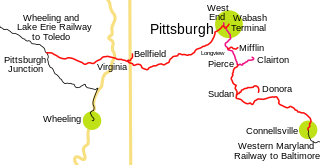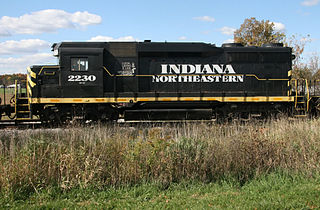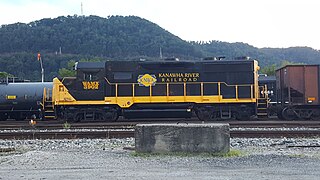Watco Companies, L.L.C. (Watco) is a transportation company based in Pittsburg, Kansas, formed in 1983 by Charles R. Webb. Watco was composed of four divisions: transportation, mechanical, terminal and port services, and compliance. Watco is the owner of Watco Transportation Services, L.L.C. (WTS), which operates 41 short line railroads in the U.S. and Australia. It is one of the largest short line railroad companies in the United States. As of December 2018, it operates on 5,500 miles (8,900 km) of leased and owned track. Also under transportation is the contract switching the company provides service for 30 customers. That was the service that Watco originally offered before it branched out into other areas.

The Alabama Southern Railroad is a class III railroad that operates in the southern United States. The ABS is one of several short line railroads owned by Watco. The railroad operates an 85-mile (137 km) line leased from the Kansas City Southern Railway. It began operating in 2005.

The Pittsburgh and West Virginia Railway was a railroad in the Pittsburgh, Pennsylvania and Wheeling, West Virginia, areas. Originally built as the Wabash Pittsburgh Terminal Railway, a Pittsburgh extension of George J. Gould's Wabash Railroad, the venture entered receivership in 1908 and the line was cut loose. An extension completed in 1931 connected it to the Western Maryland Railway at Connellsville, Pennsylvania, forming part of the Alphabet Route, a coalition of independent lines between the Northeastern United States and the Midwest. It was leased by the Norfolk and Western Railway in 1964 in conjunction with the N&W acquiring several other sections of the former Alphabet Route, but was leased to the new spinoff Wheeling and Lake Erie Railway in 1990, just months before the N&W was merged into the Norfolk Southern Railway.

The Point Pleasant Rail Bridge is a truss bridge that carries the West Virginia Secondary over the Ohio River between Gallia County, Ohio and Point Pleasant, West Virginia. At the present time, the bridge is being used by the Kanawha River Railroad for transporting goods from point to point via rail, but it was once used by Norfolk Southern, Conrail, Penn Central, and the New York Central Railroad.
The Fort Wayne Line and Fort Wayne Secondary is a rail line owned and operated by the Norfolk Southern Railway (NS), Chicago, Fort Wayne and Eastern Railroad (CFE), and CSX Transportation in the U.S. states of Pennsylvania, Ohio, and Indiana. The line runs from Pittsburgh, Pennsylvania, west via Fort Wayne, Indiana, to Gary, Indiana, along what was once the Pennsylvania Railroad's Pittsburgh to Chicago main line.
The Pittsburgh to St. Louis Main Line was a rail line owned and operated by the Pennsylvania Railroad in the U.S. states of Pennsylvania, Ohio, Indiana, and Illinois. The line ran from Pittsburgh, Pennsylvania west via Steubenville, Ohio, Columbus, Ohio, Dayton, Ohio, Indianapolis, Indiana, Terre Haute, Indiana, and Vandalia, Illinois to East St. Louis, Illinois. In addition to its east end in downtown Pittsburgh, where it met the Main Line and Pittsburgh to Chicago Main Line, junctions included the Columbus to Chicago Main Line at Columbus, the C&X Branch at Xenia, the Columbus to Indianapolis Main Line via Bradford at New Paris, the Richmond Branch and Fort Wayne Branch at Richmond, the Louisville Branch and I&F Branch at Indianapolis, and the Peoria Branch at Farrington, Illinois.

The Indiana Northeastern Railroad is a Class III short line freight railroad operating on nearly 130 miles (210 km) in southern lower Michigan, northeast Indiana and northwest Ohio. The Indiana Northeastern Railroad Company began operations in December 1992 and is an independent privately owned company. As of 2017 the railroad hauled more than 7,000 carloads per year. Commodities moved by the railroad include corn, soybeans, wheat and flour. It also handles plastics, fiberboard, aluminum, copper, coal, perlite, stone, lumber, glass, rendering products, as well as agricultural fertilizers and chemicals.
The following is a brief history of the North American rail system, mainly through major changes to Class I railroads, the largest class by operating revenue.

The Wabash Railroad was a Class I railroad that operated in the mid-central United States. It served a large area, including track in the states of Ohio, Indiana, Illinois, Iowa, Michigan, and Missouri and the province of Ontario. Its primary connections included Chicago, Illinois; Kansas City, Missouri; Detroit, Michigan; Buffalo, New York; St. Louis, Missouri; and Toledo, Ohio.

The Lehigh Line is a railroad line in central New Jersey and northeastern Pennsylvania, in the United States. It is owned and operated by the Norfolk Southern Railway. The line runs west from the vicinity of the Port of New York and New Jersey to the Susquehanna River valley at the south end of the Wyoming Valley Coal Region. Administratively it is part of Norfolk Southern's Keystone Division (Harrisburg) and is also part of the Crescent Corridor. As of 2021 the line is freight-only, although there are perennial proposals to restore passenger service over all or part of the line.

The Cleveland Line is a railroad line owned and operated by Norfolk Southern Railway (NS), in the U.S. states of Ohio and Pennsylvania. The line runs from Rochester, Pennsylvania to Cleveland, Ohio along a former Pennsylvania Railroad line.

The Kanawha River Railroad is a common-carrier railroad in the United States. A subsidiary of Watco, it leases 309 miles of track in the US states of Ohio and West Virginia from Norfolk Southern. The KNWA also operates an additional 6 miles of track on the southern side of the Kanawha River, where the railroad breaks down, loads, and rebuilds coal trains before handing them off to CSX Transportation.
The Delmarva Central Railroad is an American short-line railroad owned by Carload Express that operates 188 miles (303 km) of track on the Delmarva Peninsula in the states of Delaware, Maryland, and Virginia. The railroad operates lines from Porter, Delaware to Hallwood, Virginia and from Harrington, Delaware to Frankford, Delaware along with several smaller branches. The DCR interchanges with the Norfolk Southern Railway and the Maryland and Delaware Railroad. The railroad was created in 2016 to take over the Norfolk Southern Railway lines on the Delmarva Peninsula. The DCR expanded by taking over part of the Bay Coast Railroad in 2018 and the Delaware Coast Line Railroad in 2019.

The Kanawha Bridge is an abandoned railway bridge over the Kanawha River in Charleston, West Virginia. The bridge is of a Parker through-truss design. The bridge is located east of the Patrick Street Bridge and is now named the "Travis L. Castle Railroad Trestle."
The Princeton–Deepwater District is a rail line in West Virginia that connects Deep Water, West Virginia, on the Kanawha River southwards to Princeton, West Virginia, and beyond to rail lines leading to Virginia. It is known for its rugged terrain and opportunities for rail photography.
The Oasis Subdivision is a rail line in and near eastern Cincinnati. It is owned by the Southwest Ohio Regional Transit Authority (SORTA) and operated by the Indiana and Ohio Railway for freight traffic.
The Wilmington and Northern Branch is a partially-abandoned railway line in the states of Delaware and Pennsylvania. It was constructed between 1869 and 1870 by the Wilmington and Reading Railroad, a predecessor of the Wilmington and Northern Railroad. At its fullest extent it connected Reading, Pennsylvania, with Wilmington, Delaware. The Philadelphia and Reading Railway leased the line in 1900. With the Reading Company's bankruptcy and the creation of Conrail in 1976 the line's ownership fragmented, and the section between Coatesville, Pennsylvania, and Birdsboro, Pennsylvania, has been abandoned.








